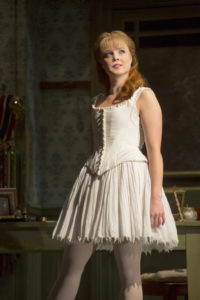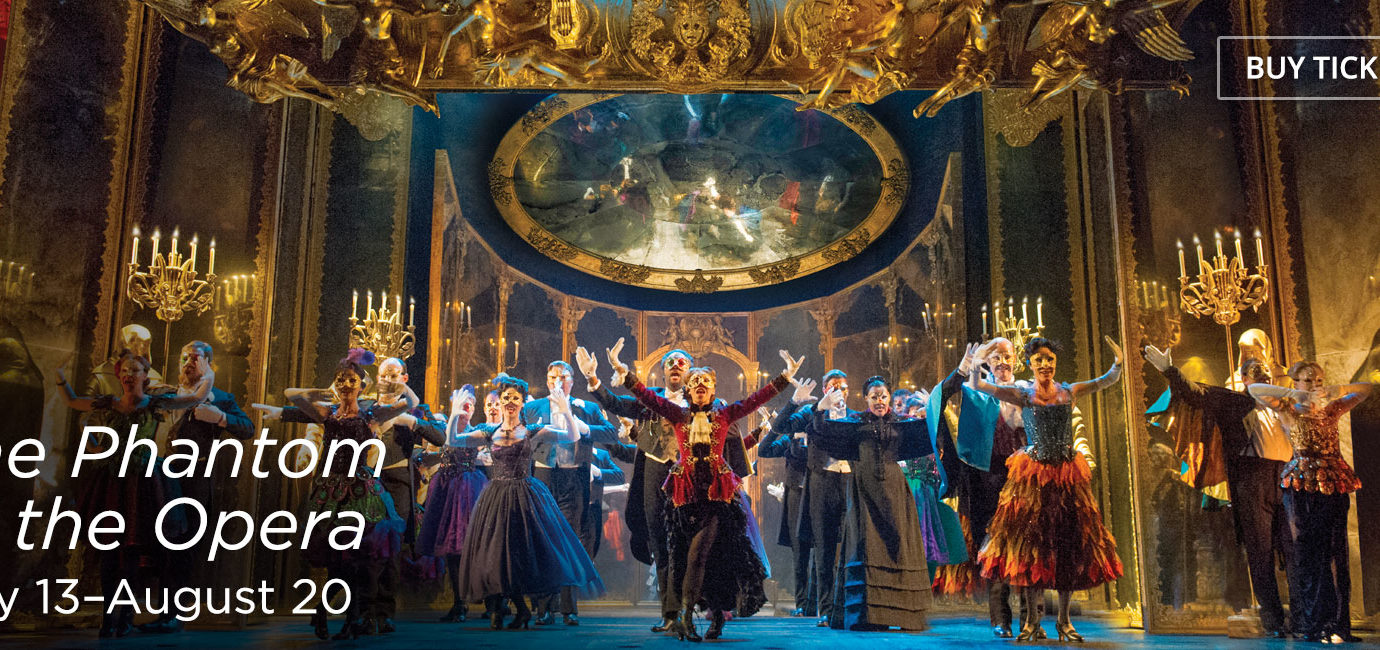Masquerade! Paper faces on parade, masquerade…take your fill let the spectacle astound you. In the newly reimagined touring production of Andrew Lloyd Webber’s The Phantom of the Opera, spectacle is the one thing the show does not seem to shy away from. Directed by Laurence Connor, with Choreography by Scott Ambler, this newly approached production attempts to drive at the heart of Webber’s story, based on the novel Le Fantôme de l’Opéra by Gaston Leroux. The haunting tale of Broadway’s most notorious love story and longest running performance on the great white way has received a facelift of sorts to reveal a new take on an old classic.
The performance, touted as spectacular, must be taken at face value— a new spin on a well-loved iconic flagstone of musical theatre history. It is not the changes from the original which makes the production difficult to swallow but rather in the show’s soul where the true distortion lies. Ignoring entirely the grandeur of its previous incarnations, this current production of The Phantom of the Opera lacks connectivity to the glorious music penned exceptionally by Webber some three decades ago; this is a result of more deeply trying to connect to the story. Unfortunately, many of the show’s production values and conceptual designs fail to live up to the hype of even the most basic touring performance of a Broadway spectacular, let alone the exceedingly high benchmarked standards that accompany this particular show.
Set Designer Paul Brown’s concept for the stage is pulled in two directions that clash with one another when they meet: minimalistically simple and overtly new-age technological. While Brown’s skeletal framework for the interior of the Opera Populaire feels rustic and appropriate, particularly when it comes to revealing the plush and lavish interior of the manager’s office or the gilded gold inlay of the box seating, it’s when this minimalist approach aligns with Video & Projection Designer Nina Dunn’s (for Knifedge) work where the collision occurs. The graveyard scene in particular features grainy and unfocused projections to create the illusion of depth alongside a rather diminished looking Daae family tombstone. Dunn’s shadow puppet play during Madam Giry’s recounting of the Phantom’s origins well serves the show, but the moving shadow of the Phantom himself in other scenes looks more like a nod to Zorro and reads like a cheap special effect rather than a haunting or terrifying shade.
The other problem with Brown’s paired down scenic concepts is Director Laurence Connor’s blocking and Scott Ambler’s choreography. In scenes like the graveyard because of the layout, the way Raoul approaches makes it impossible to believe that he does not see the Phantom straight away— a concept crucial to the sensible execution of that scene. This occurs throughout the production and pulls the audience out of the story. Brown’s approach to creating antique glass for the masquerade ball scene is poorly actualized as the mirrors that create the hall and backdrop in this scene look filthy rather than distorted. The idea potentially seems to be to create a jumble of distorted characters, which would align with the lyrics of the number, but this is not the case. Ambler’s disjointed choreography more than makes up for what the visual aesthetic lacks in this scene, though it is disheartening to see such a tangle of dancers looking so off-balance, intentional or not.
Connor’s vision, which is supplemented heavily by superfluously spoken lines, falls short of connecting to the story in a myriad of ways. Webber’s music and lyrics are profoundly striking and do the storytelling on their own without the almost pregnant pauses when spoken lines wheedle their way into the show. In addition to these moments, there are movement, blocking, and scenic choices that do not fit the lyrics of the show, causing a further disconnect from the story and its telling. The immediate scene coming to mind in this vein being when the Phantom removes his own mask in the initial labyrinth encounter with Christine.
To the production’s credit, Connor does find smaller moments that do land in a striking light with the audience— Christine about to pitch herself off the rooftop before starting “All I Ask of You” being one of these more impressive discoveries. Brown’s revolving staircase that leads to the bowels of the opera house is visually astonishing, while the lair itself is rather dreary, though this fits well within the believable bounds of how a creature scorned by the world would actually take up residence in the underbelly of an opera house. The biggest confusion of design elements comes from the illumination of Lighting Designer Paule Constable. There are clearly defined moments when the element of light feels like an additional character trying to work its presence into the scene and symbolize or represent something. These moments, however, do not always align with what’s actually happening in the scene. At other times Constable’s lighting has a cheapness too it— the blood red flood to welcome the Phantom into the masquerade ball scene comes to mind as it is poorly reflected against the purposefully squalid mirror glass.
The place where production values succeed without question are in the threads. Costume Designer Maria Björnson’s (Tony Award Winner for the original costumes in The Phantom of the Opera) iconic look is preserved flawlessly and carries the physical appeal of the show’s overall aesthetic. The decision to use Björnson’s original design work (or costumes quite closely adapted thereof) seems not to fit the overall approach of redesigning the show— why completely restage, re-block, redesign and redevelop the show in its entirety except for the costumes? While beautiful and befitting of the characters, these glamorous costumes complete in their rich decadence feel out of place with the modernized element and minimalized production values of the show on the whole, creating yet another discord for the performance.

Vocal performances across the board among the principals are inconsistent with the exception of Meg Giry (Morgan Cowling) and Christine Daae (at this performance, understudy Kaitlyn Davis.) Though Cowling’s character is only featured in “Angel of Music”, a duet with Christine, her sense of pitch and intonation is flawless, her verses are delivered with sweet delight and vocal tenacity, and she holds her own as a cameo character, particularly in scenes with her stalwart mother, Madame Giry (Anne Kanengeiser.) Taking on the rather severe ballet matron, Kanengeiser delivers the ferocious attitude of the character but falters in her vocal consistency when singing. Some lines break off mid-song and drift into being spoken or shouted, whether this is an intentional choice is unclear, but it sounds somewhat sloppy. Kanengeiser does captivate the audience with her retelling of how she encountered the phantom so many years ago close to the top of the second act.
Other vocally solid performances were given by Jacquelynne Fontaine, playing Carlotta Guidicelli, David Benoit and Price Waldman, playing Monsieur’s Firmin and André, and Phumzile Sojola playing Ubaldo Piangi. The problems that come into play with these performances are not vocal clarity, pitch, or consistency but rather their acting approach to the characters, with the exception of Fontaine who is every bit the diva that Carlotta’s text and lyrics purport her to be. Sojola’s portrayal of Piangi is bland outside of his thunderous tenor sound, and both Benoit and Waldman have fallen into the trap of making the new Opera House Managers caricatures rather than characters. Forcing comedy into moments that were already subtly comedic by design, turns Firmin and André into a bad comic trope rather than carefully constructed side players.
Kaitlyn Davis, who at this performance took on the role of Christine Daae with tremendous aplomb, was the most impressive and vocally consistent performer on the stage. Filled with heart and an unwavering connectivity to the score’s emotional constitution, Davis was a flawless representation of what Christine Daae is meant to be. Vocally sincere, in addition to possessing a voice that fuels the Phantom’s obsession, Davis melded into harmonies with both The Phantom and Raoul seamlessly. Her rendition of “Think of Me” as well as her half of “The Point of No Return” were delivered with remarkable clarity and exacting precision when it came to sustains, carries, and pitch-perfect resonation of notes. “Wishing You Were Somehow Here Again” was the show stopper for Davis as she connected on multiple emotional levels, infusing Christine with a plethora of tempestuously dark and harrowing feelings, each of which swelled through the number rising and cresting across her naturally astounding voice and crashing out into the audience with fully charged gusto.
Davis succeeded in carrying the harmonies of numbers like “The Phantom of the Opera” and “All I Ask of You”, duets shared with the Phantom (Chris Mann) and Raoul (Storm Lineberger) respectively. Her ability to create vocal nuance in these duets saves these songs from Mann’s modified vowels and overtly over-articulated delivery and from Lineberger’s inability to successfully locate and maintain intonation. While both Mann and Lineberger have exceptionally strong voices, which are often quite beautiful, they fall short of leading man quality when it comes to consistency with their execution of their songs. Lineberger, though he struggles a fair bit especially in “All I Ask of You” with starting in the correct key, does have a surprisingly resplendent sound once he settles into the correct pitch. His characterization of Raoul is enchanting, especially when the opening transformation swirls around him like a moment of his memory coming to life.
Mann, who does have a keen sense of pitch, ends up creating a sound that is just too distorted to be believable because of the way he modifies his vowels and breathes through certain phrases in certain songs, particularly in “The Music of the Night.” Not to be completely dismissed, as he does have a powerful stage presence; Mann delivers the Phantom with a layer of puerile emotions which align perfectly with his hermitic existence. There is nuance to his performance, if understated, and a series of raw exposures during numbers like “All I Ask of You (Reprise)” finds the vulnerability of the character if not the humanity.
The production simply lacks magic. There are beautiful and striking moments sprinkled throughout the performance and each character does have a moment where they truly shine, unfortunately, the production is faulted more than it is fabulous and there are not enough consistently brilliant moments interwoven with one another to live up to the expectation of a national tour.
Running Time: 2 hour and 35 minutes with one intermission
The Phantom of the Opera plays through August 20, 2016 on the Opera House Stage of The John F. Kennedy Center for Performing Arts— 2700 F Street NW in Washington, DC. For tickets call the box office at (202) 467-4600 or purchase them online.
To read the TheatreBloom exclusive interview with Julia Udine and Storm Lineberger, click here.

